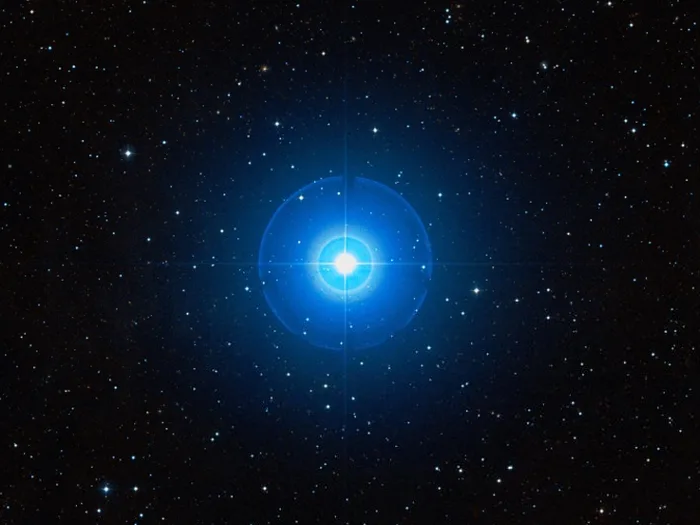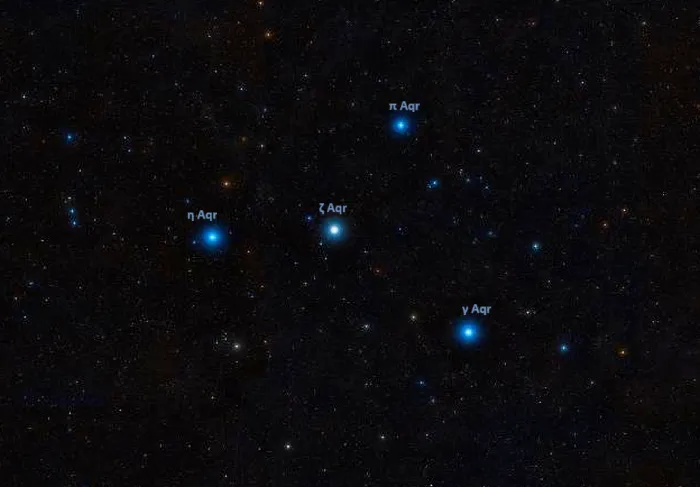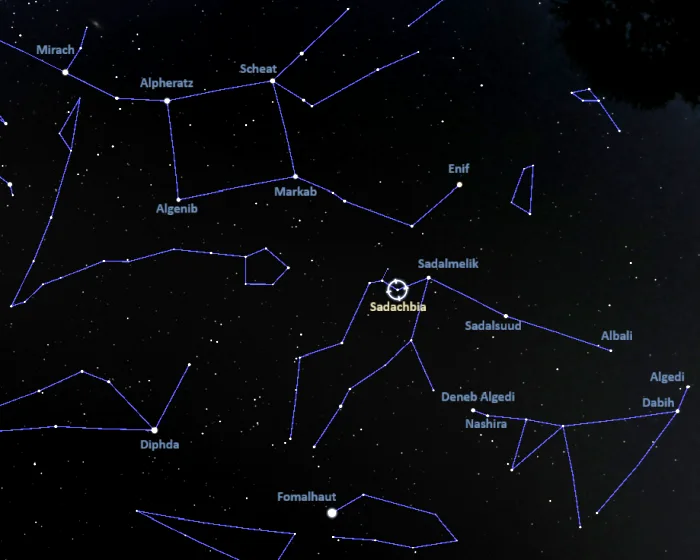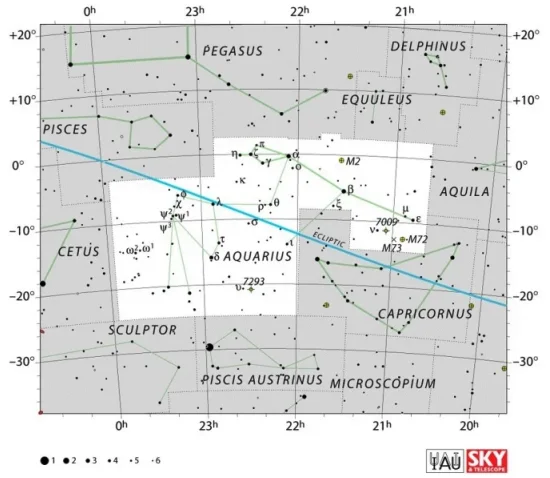Sadachbia, Gamma Aquarii (γ Aqr), is a binary star located approximately 164 light years away in the zodiac constellation of Aquarius. With an apparent magnitude of 3.849, it is the eighth brightest star in the constellation. It forms the Water Jar asterism with Zeta, Eta and Pi Aquarii.
Star system
Gamma Aquarii is a spectroscopic binary star system composed of a main sequence star of the spectral type A0 V and a K-type low-mass companion. The two components are separated by only 1.9 astronomical units (Earth – Sun distances) and have an orbital period of about a year.
The primary component, Gamma Aquarii Aa, is formally known as Sadachbia. It has 2.72 times the Sun’s mass and a radius 2.7 times that of the Sun. With a surface temperature of 10,637 K, it has the hot white glow typical for an A-type star.
Sadachbia is a fast spinner. It has a projected rotational velocity of 80 km/s. It is much younger than the Sun, with an estimated age of only 280 million years. The star is moving in the direction of the Sun with a radial velocity of -16 km/s.
The secondary component, Gamma Aquarii Ab, has a mass of 0.56 solar masses and a radius of 0.5 solar radii. With an effective temperature of 3,900 K, the star is classified as an orange dwarf.
Gamma Aquarii Aa and Ab appear as a single star and cannot be resolved even in the largest of telescopes. The star system was first resolved interferometrically in 2024.

Sadachbia (Gamma Aquarii), image credit: ESO/Digitized Sky Survey 2 (CC BY 4.0)
Facts
Sadachbia forms the Water Jar of Aquarius with Zeta Aquarii, Eta Aquarii, and Pi Aquarii. Also known as the Urn, the Y-shaped asterism represents the jar (or an amphora) from which the Water Bearer is pouring water towards the mouth of the Southern Fish (Piscis Austrinus), marked by the bright Fomalhaut (Alpha Piscis Austrini). The faint curving stream of stars representing the water flowing to Fomalhaut can be made out on a very clear, dark night.
In antiquity, the stream of water was considered to be a separate constellation, called Hydor (Water). The name Hydor was once believed to apply to the star Lambda Aquarii, but is now thought to refer to one of the fainter stars in the constellation Cetus (the Sea Monster). The IAU approved the name for the blue subgiant 2 Ceti (mag. 4.483) in 2025.

The Water Jar of Aquarius, image credit: ESO/Digitized Sky Survey 2 (CC BY 4.0)
Gamma Aquarii Ab was discovered in 2024, when a team of astronomers led by Idel Waisberg reported the direct detection of the companion at a separation of 38.2 milliarcseconds. The astronomers observed the Gamma Aquarii system with the GRAVITY instrument on the Very Large Telescope Interferometer (VLTI). They found a mass 46% that of the Sun for the companion star based on the Gaia DR3 distance or 55% of the Sun’s mass based on the Hipparcos distance. The were able to partially resolve the primary component and measured an angular diameter of 52 milliarcseconds.
Sadachbia has been suspected to be a binary system since 1914, when Lee reported detecting variable radial velocity and flagged the star as a suspected spectroscopic binary. However, the companion was not detected even using speckle interferometry in the 1970s and 1980s.
In 2000, Voges et al. detected an X-ray source based on the ROSAT All-Sky Survey. The X-ray emission hinted at the presence of a companion because it was unlikely to come from the primary star.
Sadachbia is a suspected member of the disputed Hyades Supercluster (Hyades Stream), a large grouping of stars that share a similar proper motion as the members of the Hyades cluster in the constellation Taurus.
Name
The name Sadachbia (pronunciation: /səˈdækbiə/) comes from the Arabic phrase sa‘d al-’axbiyah, meaning “luck of the homes” or “luck of the tents.” Alternatively, the phrase is taken to mean “the lucky star of hidden things” or “the lucky star of hiding places.” Gamma Aquarii was also historically called Sadalachbia (from Al Sad al Ahbiyah).
Sadachbia was part of the old Arabic lunar mansion called al Aḣbiyah, “the Tent,” along with Pi Aquarii, Eta Aquarii, and Zeta Aquarii. The asterism corresponded to the Water Jar in Aquarius, and the four stars were known as sa’d al-akhbiya, “the lucky (stars) of the tents.”
The International Astronomical Union’s (IAU) Working Group on Star Names (WGSN) approved the name Sadachbia for Gamma Aquarii on August 21, 2016. The name was traditionally used for the whole star system but formally applies only to the primary component, Gamma Aquarii Aa.
The 17th century Egyptian astronomer Al Achsasi Al Mouakket called Gamma Aquarii Aoul al Achbiya (awwil al ahbiyah), meaning “the first luck of the homes (tents).” The name was later translated into Latin as Prima Tabernaculorum.
In Hindu astronomy, Sadachbia was called Satabhishaj or Shatabhisha, meaning “a hundred physicians.” In Tamil, it was known as Sadhayam and, in Malayalam, as Chathayam. The name Shatabhisha originally applied to the red giant Lambda Aquarii and was likely used for Gamma Aquarii by error. The IAU officially approved the name for Lambda Aquarii in 2025.
In old Chinese astronomy, Gamma Aquarii was called 墳墓二 (Fén Mù èr), the Second Star of Tomb. It formed the Tomb asterism with the Water Jar stars Zeta Aquarii, Pi Aquarii, and Eta Aquarii. The asterism was part of the larger Rooftop mansion, one of the northern mansions of the Black Tortoise.
Location
Sadachbia is easy to find on a clear night because it is part of a conspicuous asterism. It is the southernmost star in the Water Jar.
The Water Jar appears south of the imaginary line drawn from Markab in the Great Square of Pegasus to Enif at the snout of Pegasus. Enif appears west of the Great Square and is part of an asterism known as the Lightning Bolt, also formed by Sadalsuud and Sadalmelik in Aquarius and Deneb Algedi in Capricornus.
At declination of −01° 23′, Sadachbia lies close enough to the celestial equator to be visible from any location on Earth for at least part of the year.

Sadachbia location, image: Stellarium
Constellation
Sadachbia is located in the constellation Aquarius. It appears in the right arm of the Water Bearer. Aquarius is the 10th largest constellation in the sky, stretching across an area of 980 square degrees. It is one of the Greek constellations, catalogued by Claudius Ptolemy of Alexandria in the 2nd century CE. Like all zodiac constellations, it lies on the ecliptic (the Sun’s apparent path across the sky) and is invisible for about a month each year when the Sun appears to pass through it.
In Greek mythology, Aquarius is associated with Ganymede, the cup bearer to the Olympian gods, as well as with Deucalion, the son of Prometheus who built a chest and survived the great flood.
In spite of its large size, Aquarius does not stand out in the night sky. Its brightest star, the yellow supergiant Sadalsuud (Beta Aquarii), shines at magnitude 2.87 from a distance of 542 light-years.
Other relatively bright stars in the constellation include the yellow supergiant Sadalmelik (Alpha Aquarii), the white main sequence star Skat (Delta Aquarii), the triple star Zeta Aquarii, the orange giant Safina (88 Aquarii), the slow irregular variable red giant Shatabhisha (Lambda Aquarii), and the binary star Epsilon Aquarii (Albali).
Aquarius also hosts the red dwarf TRAPPIST-1 with seven orbiting planets, the nearby triple star system EZ Aquarii, the symbiotic star R Aquarii, and the yellow dwarf WASP-47 with four exoplanets.

Aquarius constellation map by IAU and Sky&Telescope magazine (Roger Sinnott & Rick Fienberg) (CC BY 3.0)
Deep sky objects in Aquarius include the Helix Nebula (NGC 7293), the Saturn Nebula (NGC 7009), the peculiar galaxies NGC 7727 and the Atoms for Peace Galaxy (NGC 7252), and the bright globular clusters Messier 2 and Messier 72.
The best time of the year to observe the stars and deep sky objects in Aquarius is during the month of October, when the constellation climbs higher above the horizon in the early evening. The entire constellation can be seen from locations south of the latitude 65° N.
The 10 brightest stars in Aquarius are Sadalsuud (Beta Aqr, mag. 2.87), Sadalmelik (Alpha Aqr, mag. 2.942), Skat (Delta Aqr, mag. 3.28), Zeta Aquarii (mag. 3.65), Safina (88 Aqr, mag. 3.679), Shatabhisha (Lambda Aqr, mag. 3.722), Albali (Epsilon Aqr, mag. 3.77), Sadachbia (Gamma Aqr, mag. 3.849), 98 Aquarii (mag. 3.97), and Eta Aquarii (mag. 4.04).
Sadachbia – Gamma Aquarii
| Spectral class | A0 V |
| U-B colour index | −0.092 |
| B-V colour index | −0.060 |
| Apparent magnitude | 3.849 |
| Absolute magnitude | +0.10 |
| Distance | 164 ± 9 light-years (50 ± 3 parsecs) |
| Parallax | 25.8551 ± 0.5799 mas |
| Radial velocity | −15.70 ± 0.9 km/s |
| Proper motion | RA: +134.223 ± 0.644 mas/yr |
| Dec.: +11.219 ± 0.763 mas/yr | |
| Constellation | Aquarius |
| Right ascension | 22h 21m 39.3715681296s |
| Declination | −01° 23′ 14.457098796″ |
| Names and designations | Sadachbia, Sadalachbia, Gamma Aquarii, Gamma Aqr, γ Aquarii, γ Aqr, 48 Aquarii, 48 Aqr, HD 212061, HR 8518, HIP 110395, SAO 146044, FK5 842, GJ 9779, BD−02°5741, AG-01 2732, GC 31257, PLX 5407.00, PPM 181446, SKY# 42583, GEN# +1.00212061, GSC 05226-01606, ALS 16209, CSI-02 5741 1, HGAM 1061, N30 4927, GCRV 14062, PMC 90-93 590, ROT 3254, AKARI-IRC-V1 J2221394-012314, JP11 3475, TD1 29003, 1RXS J222140.1-012310, UBV 19127, UBV M 26339, YZ 91 7780, WEB 19798, uvby98 100212061, TIC 439852017, TYC 5226-1606-1, IRAS 22190-0138, 2MASS J22213936-0123145, Gaia DR2 2677558895240612992, Gaia DR3 2677558895241364864, ADS 15864, CCDM J22217-0123A, IDS 22165-0153 A, WDS J22217-0123A |
Gamma Aquarii Aa
| Mass | 2.72 ± 0.04 M☉ |
| Radius | 2.7 R☉ |
| Temperature | 10,637 ± 362 K |
| Metallicity | +0.30 dex |
| Age | 280 ± 20 million years |
| Rotational velocity | 80 km/s |
| Surface gravity | 3.99 ± 0.14 cgs |
Gamma Aquarii Ab
| Mass | 0.56 M☉ |
| Radius | 0.5 R☉ |
| Temperature | 3,900 K |